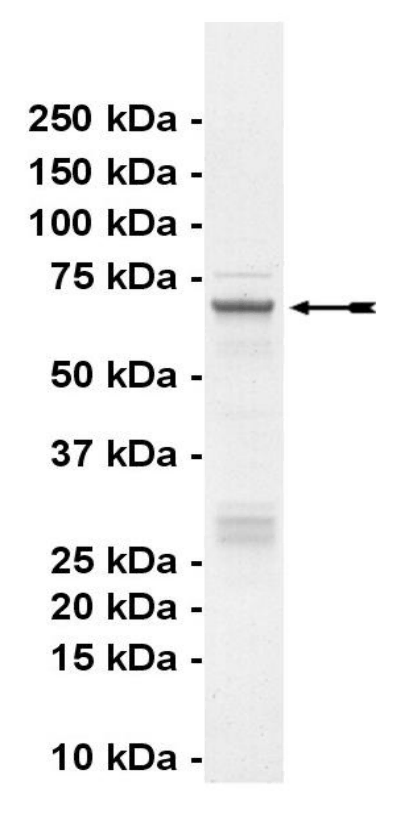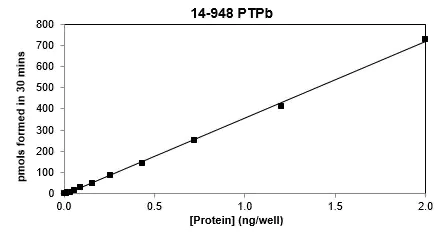PTPβ, active
N-terminal GST-tagged recombinant, human PTPβ amino acids 1643-end.
Biological information
Background
This protein is a member of the protein tyrosine phosphatase (PTP) family. PTPs are known to be signaling molecules that regulate a variety of cellular processes including cell growth, differentiation, mitotic cycle, and oncogenic transformation. This PTP contains an extracellular domain, a single transmembrane segment and one intracytoplasmic catalytic domain, thus belongs to receptor type PTP. The extracellular region of this PTP is composed of multiple fibronectin type_III repeats, which was shown to interact with neuronal receptor and cell adhesion molecules, such as contactin and tenascin C. This protein was also found to interact with sodium channels, and thus may regulate sodium channels by altering tyrosine phosphorylation status. The functions of the interaction partners of this protein implicate the roles of this PTP in cell adhesion, neurite growth, and neuronal differentiation.
GenBank NM_002837.2
Target class
Phosphatase
Family
Accession number
NM_002837.2
Target Name
PTPβ, active
Target Alias
Origin
Human
Theori. MW
69 kDa
Affinity tag
GST
Product specifications
Expression system
Expressed in E. coli
Purity
Purity 87% by SDS-PAGE and Coomassie blue staining.
Purification method
Glutathione agarose affinity chromatography
Sample Buffer
Protein in 25mM Tris/HCl pH 8.0, 75mM NaCl, 10mM GSH, 50% glycerol, 0.5mM DTT. Frozen solution.
Specified activity
Refer to CoA
Application
For Research Only
Storage conditions
1 year at -70°C.
Usage disclaimer
For Research Only
Chemical data
Background
This protein is a member of the protein tyrosine phosphatase (PTP) family. PTPs are known to be signaling molecules that regulate a variety of cellular processes including cell growth, differentiation, mitotic cycle, and oncogenic transformation. This PTP contains an extracellular domain, a single transmembrane segment and one intracytoplasmic catalytic domain, thus belongs to receptor type PTP. The extracellular region of this PTP is composed of multiple fibronectin type_III repeats, which was shown to interact with neuronal receptor and cell adhesion molecules, such as contactin and tenascin C. This protein was also found to interact with sodium channels, and thus may regulate sodium channels by altering tyrosine phosphorylation status. The functions of the interaction partners of this protein implicate the roles of this PTP in cell adhesion, neurite growth, and neuronal differentiation.
GenBank NM_002837.2
Compound name
Phosphatase
Catalog number
14-948
Molecular formula
CAS
MW
Ka
Percent composition
Product specifications
Physical state
Purity (HPLC 214nm)
Retention time (RP18 HPLC)
CMC
Exact mass
Stability
For Research Only
Solubility structure
Kinase Activity Assay Biological information
Background
This protein is a member of the protein tyrosine phosphatase (PTP) family. PTPs are known to be signaling molecules that regulate a variety of cellular processes including cell growth, differentiation, mitotic cycle, and oncogenic transformation. This PTP contains an extracellular domain, a single transmembrane segment and one intracytoplasmic catalytic domain, thus belongs to receptor type PTP. The extracellular region of this PTP is composed of multiple fibronectin type_III repeats, which was shown to interact with neuronal receptor and cell adhesion molecules, such as contactin and tenascin C. This protein was also found to interact with sodium channels, and thus may regulate sodium channels by altering tyrosine phosphorylation status. The functions of the interaction partners of this protein implicate the roles of this PTP in cell adhesion, neurite growth, and neuronal differentiation.
GenBank NM_002837.2
Target class
Phosphatase
Family
Subfamily
Protein Name
PTPβ
Protein Alias
Accession Number
NM_002837.2
UniProt Number
Gene Name
Gene ID
Gene Aliases
Target Species
Human
Kinase Activity Assay Usage
Product Type
Application
Storage Conditions
1 year at -70°C.
Usage disclaimer
Kinase Activity Assay Information
Assay Type
Assay Measures
Biological Information
Background
This protein is a member of the protein tyrosine phosphatase (PTP) family. PTPs are known to be signaling molecules that regulate a variety of cellular processes including cell growth, differentiation, mitotic cycle, and oncogenic transformation. This PTP contains an extracellular domain, a single transmembrane segment and one intracytoplasmic catalytic domain, thus belongs to receptor type PTP. The extracellular region of this PTP is composed of multiple fibronectin type_III repeats, which was shown to interact with neuronal receptor and cell adhesion molecules, such as contactin and tenascin C. This protein was also found to interact with sodium channels, and thus may regulate sodium channels by altering tyrosine phosphorylation status. The functions of the interaction partners of this protein implicate the roles of this PTP in cell adhesion, neurite growth, and neuronal differentiation.
GenBank NM_002837.2
Target class
Phosphatase
Family
Accession Number
NM_002837.2
Target Name
PTPβ
Target Alias
Origin
Human
Theoretical MW
Affinity Tag
GST
Product Specifications
Expression system
Expressed in E. coli
Purity
Purity 87% by SDS-PAGE and Coomassie blue staining.
Purification method
Glutathione agarose affinity chromatography
Sample Buffer
Specified activity
Refer to CoA
Application
Storage conditions
1 year at -70°C.
Usage disclaimer
For Research Only
Biological Information
Background
This protein is a member of the protein tyrosine phosphatase (PTP) family. PTPs are known to be signaling molecules that regulate a variety of cellular processes including cell growth, differentiation, mitotic cycle, and oncogenic transformation. This PTP contains an extracellular domain, a single transmembrane segment and one intracytoplasmic catalytic domain, thus belongs to receptor type PTP. The extracellular region of this PTP is composed of multiple fibronectin type_III repeats, which was shown to interact with neuronal receptor and cell adhesion molecules, such as contactin and tenascin C. This protein was also found to interact with sodium channels, and thus may regulate sodium channels by altering tyrosine phosphorylation status. The functions of the interaction partners of this protein implicate the roles of this PTP in cell adhesion, neurite growth, and neuronal differentiation.
GenBank NM_002837.2
Target class
Phosphatase
Family
Accession Number
NM_002837.2
Target Name
PTPβ
Target Alias
Origin
Human
Theoretical MW
Affinity Tag
GST
Product Specifications
Expression system
Expressed in E. coli
Purity
Purity 87% by SDS-PAGE and Coomassie blue staining.
Purification method
Glutathione agarose affinity chromatography
Sample Buffer
Specified activity
Refer to CoA
Application
Storage conditions
1 year at -70°C.
Usage disclaimer
For Research Only





